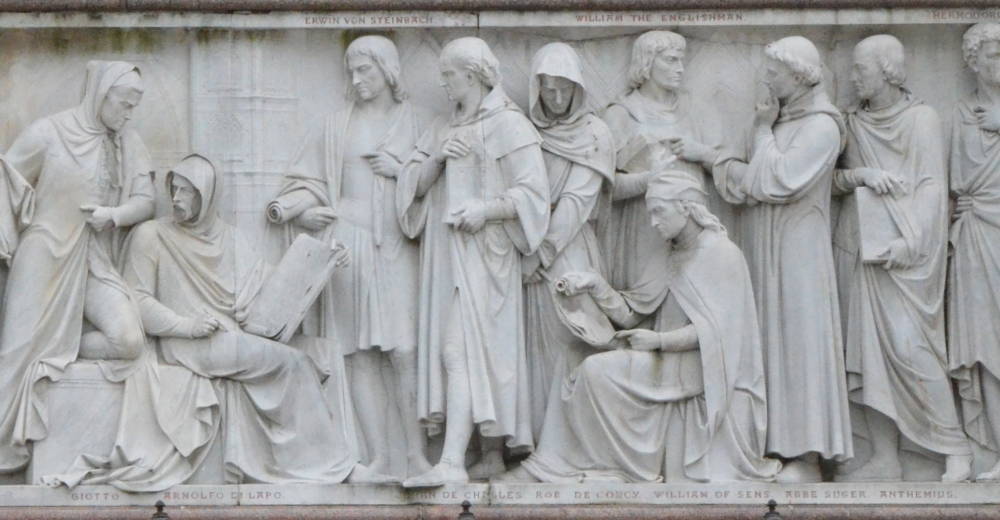
Bradey and Pevsner attribute the friezes on the base of the memorial to both H. H. Armstead and J. Birnie Philip, but do not identify creators of specific ones. John Lucas Tupper's 1872 essay on Armstead, however, states that Armstead created those representing the great — that is, the canonical — poets, composers, and painters in the Western tradition, leaving the remainder, one assumes, for Philip: “The podium of the Albert Memorial may be described as a cube with the angles cut off, and solid oblongs affixed to the cut surfaces. Here are, therefore, sixteen upright surfaces. Eight of these, entrusted to the chisel of Mr. Armstead, are dedicated to Poetry, Music, and Painting; without reference to the wings, which necessarily stand obliqluely; these are the south and east surfaces, containing eighty life-size figures.” Information about the dates and activities of the sculptors depicted comes from both Britannica and Wikipedia; the latter's article, “The Frieze of Parnassus” proved especially helpful. [Click on photographs to enlarge them.]

Left to right: Augustus Welby Pugin (1812-1852), Sir George Gilbert Scott (1811-78), Samuel Pepys Cockerell (1754–1827) , Sir Charles Barry (1795-1860), Sir William Chambers (1723-96), John Vanbrugh (1664-1726), Sir Christopher Wren (1632-1723), Inigo Jones (1573-1652), François Mansart (1598-1666), and James Thorpe (fl. 1570-1610).
Barry, Chambers, Jones, Pugin, Thorpe, Wren, and Wykeham also appear on the Victoria and Albert Museum's façade, which provides a pantheon of British artists, sculptors, and artisans. Scott, who designed the Albert memorial and conceived the frieze, having been “inspired” by the Hémicycle des Beaux Arts” by Hippolyte Delaroche” (Wikipedia), appears among the greats in this work completed six years before his death.

Left to right: Philibert Delorme (c. 1515-1570), Andrea Sansovino [original name Andrea Contucci] (c. 1467-1529), Donato Bramante, (c. 1444 1514), William of Wyncham [Wykeham or Wickham] (1324-1404), Leon Battista Alberti (1404-72), Filippo Brunelleschi (1377-1446).

Left to right: Giotto di Bondone, (1266–67/1276-1337), Arnolfo de Lupo [Arnolfo di Cambio] (c. 1245-1301/10), Erwin van Steinbach (c. 1244–1318), Jehan de Chelles (fl. 1258–65), William the Englishman (fl. 1174-1214), Rob de Concy (d. 1311), William of Sens (d. 1180), Abby Suger (1081-1151), Anthemius of Tralles (c. 474–before 558). The Frenchman Guillaume de Sens is the “French master-mason who built the first structure in the Early Gothic style in England.” After falling from a scaffold during the construction of the choir of Canterbury Cathedral, his health prevented him from working; he “returned to France, where he died. His successor, William the Englishman, seems to have followed his plans.” (Britannica). Anthemius designed Hagia Sofia in then-Constantinople.
Photograph, formatting, caption, and perspective correction by the author. You may use these images without prior permission for any scholarly or educational purpose as long as you (1) credit the photographer and (2) link your document to this URL in a web document or cite the Victorian Web in a print one.]
Bibliography
Tupper, J. L. “Henry Hugh Armstead,” English Artists of the Present Day. Essays” by J. Beavington Atkinson, Sidney Colvin, F. G. Stephens, Tom Taylor, and John L. Tupper. London: Seeley, Jackson, and Halliday, 1872, 61-66.
Pevsner, Nikolaus. Berkshire. London: Penguin, 1988.
Last modified 12 November 20111